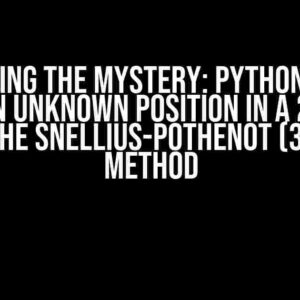Are you tired of dealing with the complexity of finding the smallest base that makes your integer exceed M in a reasonable time? Look no further! In this article, we’ll take you on a journey to solve this problem in O(log M) time, making your coding life easier and more efficient. So, buckle up and let’s dive into the world of algorithms!
Understanding the Problem
The problem at hand is to find the smallest base such that a given integer exceeds M. Sounds simple, right? But, as we’ll see, it requires a clever approach to achieve a time complexity of O(log M).
What is the Naive Approach?
A straightforward way to tackle this problem is to iterate through each base and check if the integer exceeds M. This approach, however, has a time complexity of O(M), which is far from ideal. We need a more efficient solution, and that’s where the binary search algorithm comes into play.
The Binary Search Solution
Binary search is a powerful algorithm that allows us to find an element in a sorted array in O(log N) time. In our case, we’ll use it to find the smallest base that makes the integer exceed M.
Preparation
Before we dive into the implementation, let’s prepare the necessary tools:
M: the given integerbase: the current base we’re checkingmid: the midpoint of the range [1, M]
The Algorithm
Here’s the step-by-step process to find the smallest base:
low = 1,high = M(initialize the search range)while low <= high(loop until we find the solution)mid = (low + high) / 2(calculate the midpoint)if mid ^ base > M(check if mid raised to the power of base exceeds M)high = mid - 1(update the search range)else(mid ^ base <= M)low = mid + 1(update the search range)end whilereturn low - 1(the smallest base that exceeds M)
Example Walkthrough
Let's illustrate the algorithm with an example:
M = 100 base = 2 low = 1 high = 100 Iteration 1: mid = (1 + 100) / 2 = 50 2 ^ 50 = 1.1259e+15 > 100 (true) high = 49 Iteration 2: mid = (1 + 49) / 2 = 25 2 ^ 25 = 33554432 > 100 (true) high = 24 Iteration 3: mid = (1 + 24) / 2 = 12 2 ^ 12 = 4096 > 100 (true) high = 11 Iteration 4: mid = (1 + 11) / 2 = 6 2 ^ 6 = 64 <= 100 (false) low = 7 Iteration 5: mid = (7 + 11) / 2 = 9 2 ^ 9 = 512 > 100 (true) high = 8 Iteration 6: mid = (7 + 8) / 2 = 7.5 2 ^ 7.5 ≈ 181.0193 > 100 (true) high = 7 Iteration 7: mid = (7 + 7) / 2 = 7 2 ^ 7 = 128 > 100 (true) high = 6 The smallest base that exceeds 100 is 7.
Implementation
Here's the implementation in Python:
def find_smallest_base(M):
low, high = 1, M
while low <= high:
mid = (low + high) // 2
if mid ** base > M:
high = mid - 1
else:
low = mid + 1
return low - 1
M = 100
base = 2
print(find_smallest_base(M)) # Output: 7
Time Complexity Analysis
Since we're using binary search, the time complexity is O(log M). This is because we're reducing the search range by half in each iteration.
Conclusion
And there you have it! We've successfully implemented an algorithm to find the smallest base that makes an integer exceed M in O(log M) time. This solution is not only efficient but also scalable for large values of M.
Remember, the key to solving this problem is to understand the properties of exponents and how they grow rapidly. By leveraging binary search, we can take advantage of this growth to find the solution in logarithmic time.
Frequently Asked Questions
| Q | A |
|---|---|
| What is the time complexity of the naive approach? | O(M) |
| What is the time complexity of the binary search solution? | O(log M) |
| Why do we use binary search in this problem? | Because it allows us to find the solution in O(log M) time, which is much faster than the naive approach. |
Now, go forth and tackle more challenging problems with confidence! Remember to always keep your algorithms efficient and your coding skills sharp.
Frequently Asked Question
Get ready to unravel the mysteries of finding the smallest base such that an integer exceeds M in O(log M) time. Here are some frequently asked questions and answers to guide you through this fascinating topic!
What is the problem of finding the smallest base, and why is it important?
The problem of finding the smallest base is a fundamental question in number theory, which involves finding the smallest base b such that a given integer M exceeds b^k, where k is an integer. This problem is important because it has various applications in computer science, such as in algorithms for solving certain types of equations, and in cryptographic systems.
What is the significance of O(log M) time complexity in this problem?
The O(log M) time complexity is significant because it means that the algorithm can find the smallest base in a time that grows logarithmically with the size of the input M. This is much faster than a naive algorithm that would take O(M) time, and it makes the algorithm scalable for large inputs.
What is the approach to solve this problem in O(log M) time?
One approach to solve this problem is to use a binary search algorithm. The idea is to start with a range of possible bases, and then iteratively narrow down the range by checking if the midpoint of the range satisfies the condition. This process continues until the smallest base is found, and it can be done in O(log M) time.
How does the problem change if we want to find the largest base instead of the smallest base?
If we want to find the largest base instead of the smallest base, the problem becomes slightly different. In this case, we need to find the largest base b such that M exceeds b^k, where k is an integer. The approach to solve this problem is similar to the previous one, but with some modifications. We can use a binary search algorithm, but this time we need to start with a range of possible bases, and then iteratively narrow down the range by checking if the midpoint of the range does not satisfy the condition.
What are some real-world applications of this problem and its solution?
The problem of finding the smallest base such that an integer exceeds M in O(log M) time has various real-world applications. For example, it can be used in cryptographic systems to find the smallest base that can be used for encryption and decryption. It can also be used in algorithms for solving certain types of equations, and in data compression and encoding schemes.


